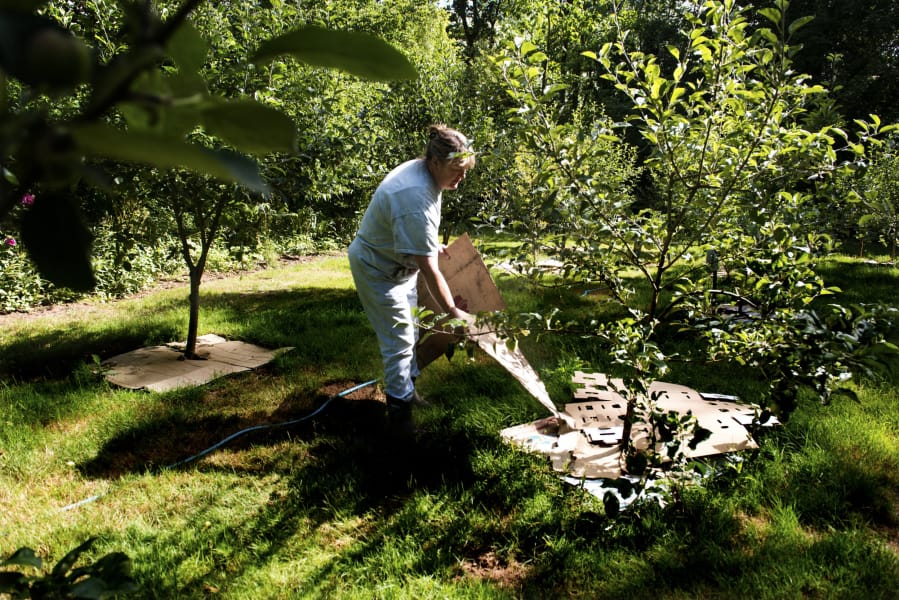Brenda and Bob Calvert of Half Moon Farm do a lot on a little.
The 8-acre farm grows fresh-cut flowers and fresh produce, raises honeybees, chickens, goats and has an apple orchard growing in. It doesn’t rely on conventional agricultural techniques of packing the land with crops and tending them with chemicals.
“Our farm is not only for farming but for keeping natural wildlife habitat,” Brenda Calvert said. “We’re working with habitat, not stripping it away.”
Developing that connection with the environment has come in large part from the connection the Calverts have had with the Clark Conservation District. But the district’s precarious financial situation might mean a severe reduction in the services it can offer, if not a dissolution of the district itself. The Calverts say that would have a direct impact on landowners like themselves who want help improving the conditions on their farms and rural property.
“It’d be sad if we lost the conservation district. There are so many not just farmers, but school and all kinds of folks, that really rely on them,” Calvert said. “If this resource is gone, they won’t have this kind of knowledge or plants sales to help them.”
Calvert estimates she’s bought around 300 native plants from the district over two years. The district also certified their farm as salmon safe, meaning their agricultural practices protect water quality. They’ve saved hundreds of dollars by butchering chickens with the district’s poultry processing equipment instead of buying the equipment themselves or driving to Oregon to have the work done commercially.
Now, with a $7,000 grant through the district, the Calverts are plan to install a drip irrigation system, which will reduce the farm’s water consumption while still keeping its crops irrigated.
“It’s huge. I don’t think we could do the irrigation system without it,” Calvert said.
The Clark Conservation District was created in 1942 on the heels of the Dust Bowl to conserve natural resources, particularly water and soil. It’s a nonregulatory state government subdivision that helps local landowners conserve natural resources on private land in rural and urban areas free of charge. Its staff offers technical and financial assistance for landowners to control erosion, protect riparian areas, remove fish barriers and comply with regulations — among other services.
Grant limitations
Currently, the district relies on grants to fund its projects. Zorah Oppenheimer, interim manager of the Conservation District, said the requirements and funding requirements that come with grant funding leave the organization hamstrung.
“With grants, you can’t do huge amount of up-front work … you can’t spend time to line up landowners. The grant is only for a short, specified amount of time, and we can’t do long-term projects,” she said. Additionally, the district can only focus on certain geographic areas, rather than working to improve properties countywide.
The district has had an annual budget of about $368,000, about half of which goes directly to on-the-ground projects, funded entirely through state and federal grants. But at the end of the year, the district will have a balance of about $40,000. A recent white paper review of the district prepared by county staff for the Clark County Council shows the decline was not because of mismanagement, but rather “result of reliance upon grants as a funding source and the changing nature of grant sizes and availability.”
“Without a new funding source, it is likely the district will not be financially viable by the end of 2018,” it reads.
The report also found that the district’s work across the county “provides an indirect benefit in excess” of its operating budget and “the value of the environment is potentially more than $380,000.”
However, the report found many of its activities overlap with other organizations. And the magnitude of the district’s impact is questionable because the projects it serves are small, and diffuse across the landscape and chosen by grant mandates rather than severity of need or importance.
District officials say its issues can be remedied with the right funding source, so it’s asking the county council to enact a $5 per-parcel per-year charge to landowners. That would give the district about $686,000 per year, minus county fees. But so far, the council has refused to do so.
“We have grants that will get us through the next year, but our staff is so limited that we really don’t have the ability to get new grants,” Oppenheimer said. “In the next year, the best-case scenario is a part-time person sitting in an office, not available to help landowners.”
Sue Marshall is board president of Friends of Clark County. When she became co-owner of Baurs Corner Farm, a 29-acre working farm, in 2000, one of her first calls was to the district, she said.
“It’s been a great resources, and I think it’s a value in educating property owners on how best to manage their land in an environmentally sensitive way,” she said.
Marshall believes the fact that the district is a nonenforcement organization makes it easier for landowners comply with regulations without the fear of getting pulled into legal battles or facing penalties.
“I can’t speak for all farmers, but the people I associate with are concerned about the loss of the district,” she said.
Marshall said the Friends of Clark County group is supportive of funding for the district because it is one piece of a shrinking support network for rural landowners and farmers in an increasingly urbanized county.
“It forms part of the whole infrastructure that has been greatly diminished in a lot of ways. A loss of the district is one more chip away from the viability of local agriculture.”




